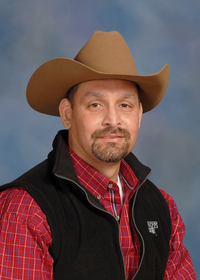Beef Cattle Grazing Management
Beef cattle production in Mississippi is primarily forage based. Cow-calf, stocker cattle, and even forage-based finishing can be accomplished using Mississippi forage systems. Mississippi is an excellent environment for forage and beef cattle production for several reasons, including:
- high average annual rainfall,
- long growing seasons,
- a wide range of forages adapted to different areas of the state,
- local resources such as poultry litter for fertilizer,
- relative availability and value of acreage for forage production compared to other states, and
- availability of forage variety evaluation data for sites within the state.
Many forage species and cultivars are researched and field-tested within the state. This gives producers local information about forage production. The forage variety testing program also provides producers with forage yield data for specific locations within the state each year.
Beef cattle producers are forage producers who use forage resources as inputs in their cattle operations. For most United States beef cattle operations, nutrition-related costs make up a significant portion and sometimes a majority of cash costs. On average, nearly 68 percent of cash costs for cow-calf operations in 2009 within Mississippi and surrounding states were nutrition-related costs (Figure 1). Harvested forage costs often comprise a large percentage of nutrition costs. Overfeeding wastes both feed and money. Underfeeding, on the other hand, can hurt cattle reproductive and growth rates.
Forages are often the most cost-effective means to supply cattle with needed nutrients. By planning the nutritional program around the forage program, efficient and effective feeding systems can be accomplished. Start by implementing a controlled breeding and calving season for cow-calf herds to better match animal nutrient needs to changing forage quality and yield throughout the year. Refer to MSU Extension Publication 2501 Calving Season Selection Considerations. Develop forage systems to match calving seasons and stocker acquisition periods. Consider animal performance, management, and marketing goals in designing appropriate forage systems.

Grazing Management Concepts
It is important to recognize and understand grazing management terminology to properly plan and implement grazing management recommendations. Grazing pressure (or stocking density) and stocking rate are often confused, but there is a distinct difference in these two concepts. Grazing pressure is the number of animals per unit of forage available, or the ratio of forage demand to forage available at any instant. Stocking rate is the number of animals per unit of land.
Optimum stocking rates depend on cattle intake and pasture productivity and quality. One rule of thumb sometimes used to manage stocking rate is to rotate grazing animals to a new paddock after they consume 50 percent of the available forage in a paddock. The effectiveness of this rule depends on factors such as initial forage availability, height of forage growing points, and grazing tolerance of forages. Some forages can be more closely grazed than others.
Overstocking occurs when stocking rate is too high. Overstocking during slow forage growth decreases the ability of forage to recover during favorable growing conditions, lowers forage persistence, and increases invasion of opportunistic species such as weeds. It also decreases animal performance if forage availability limits intake. Understocking occurs when stocking rate is too low. Understocking increases forage maturity, lowers forage quality, and decreases animal performance.
Forage Budgeting
Forage Supply and Demand
Forage supply must be adequate to meet demand by cattle and other grazing livestock. Forage supply and demand change constantly. Factors affecting forage supplies include forage species (differ by yield potential and seasonal productivity), soil fertility (low fertility reduces forage yields), climate (some forages are better adapted to and perform better in certain climates), and season (time of year and environmental factors impact forage yields and quality). Forage demand varies with animal numbers, types, weights, stage of production, and desired rate of gain. Mechanical harvest of fields for hay, baleage, or greenchop is another potential forage use.
When forage supply exceeds demand, increasing stocking rates or mechanically harvesting forage for later use or sale can help balance forage supply and demand to avoid undergrazing and forage maturity problems. When forage demand exceeds supplies, reducing stocking rates or using stored forages and other feeds can help balance forage supply and demand.
Forage budgets are useful for identifying the pasture and stored forage needs of a livestock operation. Much like a financial budget that helps manage money supply and demand, the forage budgeting process helps manage forage supply and demand. Forage budgeting is used to allocate forage resources to avoid waste from understocking or reduced animal performance and ranch carrying capacity from overstocking.
Accurate forage budgeting requires reliable estimates of forage production (yields and timing of forage growth) and intake requirements of livestock. In addition to forage yields, nutrient content (quality) must be considered in planning to meet animal nutrient demands. Very good ranch records are needed to develop and maintain effective forage budgets. These budgets identify seasonal deficiencies and surpluses in forage availability. The surpluses are then used during the deficiency periods to best match forage supply and demand. Forage budgeting worksheets are available to assist producers with forage production and utilization planning.
Forage Species Selection
A wide selection of forages can be grown in Mississippi. The growing seasons may differ from year to year based on rainfall and temperature differences. There may also be differences within Mississippi due to variations in local conditions. Precise forage selection depends on the specific location within the state, local soil types, and other environmental conditions. Using only one forage species is not adequate to provide year-round grazing. By developing a forage system of a variety of forages based on their seasonal productivity and quality, beef cattle operations can supply adequate grazing during most months of the year. Stockpiled or stored forages can be used to supply forage to cattle during periods of low forage productivity or dormancy. A good goal is to reduce the need for winter supplementation by planning grazing systems that minimize the need for stored forage and supplemental grain feeding.
Forage quality, quantity, and timing of growth determine the appropriateness of their use in specific forage systems. The distribution of forage growth varies greatly among forage species and is extremely important for planning a grazing program. Relative growth rates of warm-season grasses, such as bermudagrass, are greater than cool-season grasses, such as annual ryegrass or tall fescue, at high temperatures. However, cool-season grasses are productive over a wider temperature range.
Consider production goals and grazing management systems in forage selection decisions. Some forages are more tolerant of close grazing than others. Some forages are easier or less expensive to establish or maintain than others. Also consider compatibility of multiple forage species managed together in a pasture or hay field.
Base forage selection in part on forage adaptation. If forages are not well adapted to an area, they may fail or perform poorly. Forage adaptation is primarily dependent on climate and soils. Temperature, drought, rainfall distribution, growing season, and photoperiod are climate factors that affect forage adaptation. Environmental extremes are more likely to affect forage adaptation than average conditions. Soil pH, drainage, water-holding capacity, native fertility, and potential for pests also affect forage adaptation. Resistance to diseases and pests such as nematodes and leaf hoppers impact forage adaptation.
Botanical composition is the forage species makeup of an area. A monoculture is a single forage species grown as a crop in a paddock or field. Many hayfields are managed as monocultures.
Mixed swards are paddocks or fields that include multiple forage species managed together as one crop. Many pastures are managed as mixed swards, although monocultures are sometimes established for specific grazing purposes. A binary mixture is a mixed sward that primarily contains two forage species for cultivation. Mixed sward pastures often include tall and short plant species that respond differently to grazing intensity. Mixed swards may also contain both cool- and warm-season forages, such as bermudagrass and tall fescue grown together.
In these situations, one forage dominates yields during its primary growing season while the other forage dominates during a different period. There may be overlap among growing seasons or dormancy periods. Mixed swards can also contain combinations of grass and legumes. Fertilization and harvest practices can favor one forage over others in mixed swards. The botanical composition of a pasture influences the degree possible of forage selectivity.
To determine botanical composition, create forage inventory records for each pasture and hayfield. Estimate the percentages of plants of each forage species, weeds, bare ground, and other acreage in these inventories. A systematic approach to pasture inventory may include walking a diagonal path across the pasture and counting the items by category in this path every set number of steps. Sampling must be representative of pasture makeup to be meaningful. For example, excluding low-lying areas may result in inaccurate assessments. Botanical composition needs to be reevaluated periodically as forage stands change with seasons and over years.
Assess the forage composition of all acreage used for pasture or stored forage production. Many Mississippi beef cattle operations have an overabundance of warm-season forages as compared to cool-season acreage. This creates a situation where excess warm-season forage must be harvested for hay or wasted. In this situation, cool-season forage supplies often would not be adequate to meet cattle nutrient needs without supplementation of additional forage/feed. Instead of cattle grazing as much as possible, large amounts of forage are mechanically harvested, stored, and then fed to livestock in the winter months. This is an inefficient system.
To correct this problem, pastures should be renovated to shift the balance of forage species. Forage renovation should be planned and completed in stages. There is more production risk in renovating large proportions of acreage at once than renovating the same amount of total acreage in smaller steps over more growing seasons. If a large proportion of acreage is renovated at once and forage establishment is not successful, then total forage availability on the ranch can become limiting. Herd size would then need to be reduced or additional forage and feed brought onto the ranch to make up for forage shortfalls.
In Mississippi, grazed forage intake typically declines during autumn, is lowest in winter, and peaks during spring and summer. This corresponds with an abundance of lush spring grazing and warm-season forage production and a decline in forage availability in pastures during autumn and into winter. Feeding hay often replaces grazing during periods of low pasture forage availability. For a more efficient grazing system, forage selection and management should target ways to increase pasture forage availability during autumn and early winter.
A wide gap between forage production and consumption rates is common on many beef cattle operations. Excess production could be used by increasing stocking rates and using more efficient grazing methods. Alternately, excess forage yields could be mechanically harvested for stored forage. Developing a better balance of seasonal forage production through forage selection and management helps improve forage system efficiency.
There are good reasons to consider adding legumes to pastures. More often than not, pasture systems with the lowest total pasture costs per pound of animal gain include legumes. Legumes generally have higher crude protein and total nutrient digestibility percentages than grasses. However, they often do not produce as much dry matter yield as grasses do. Inclusion of at least one-quarter of the pasture cover as legumes can increase grazing animal performance. Stocker cattle average daily gains can improve by ¼-pound per day or more by adding legumes to pastures.
The unique ability of legumes to obtain nitrogen from the air also makes them especially valuable in forage programs. The specific amounts of nitrogen fixed (added back to the soil) per year vary by legume species, but legume nitrogen fixation levels generally range from 100 to 200 pounds of nitrogen per year. This nitrogen does not become available for other forages to use until the root nodules and other plant parts containing it break down in the soil.
A potential drawback to legumes is that they are typically less tolerant of close grazing than grasses. However, cultivars selected specifically for improved grazing tolerance are available. White clover is an example of a legume with stolons (aboveground stems that run horizontal to the ground and from which new plants can emerge) that enhance grazing tolerance.
A major reason some producers do not add legumes to pastures is the susceptibility of legumes to some commonly used pasture herbicides. Instead of viewing this as a tradeoff between weed control and legume use, consider strategic weed control practices that use herbicide selection and application timing practices that provide for both weed control and legume stand maintenance.
On very acidic soils, legume establishment and maintenance is difficult. Soil testing and liming well in advance of legume planting is needed for successful legume establishment. Also make sure that proper legume seed inoculation is practiced before planting. Drought tolerance is sometimes noted as a problem with managing legumes, but this can be addressed through species and cultivar selection, use on soils with acceptable water-holding capacity, and irrigation practices when warranted.
Forage Harvest Method
Forage can be harvested by grazing livestock or by machinery. It can be provided to cattle in many forms including grazing, hay, silage, and greenchop. Allowing animals to harvest forage reduces machinery and related harvest and feeding expenses. It also allows for animal selectivity and can be a very efficient method of forage use when managed properly. However, mechanical harvest of forage provides options for long-term storage and can be used to match forage supply and demand throughout the year. Mechanical harvest also allows forage to be used from fields that are not fenced or do not have adequate water supplies to contain grazing animals.
Hay
Hay is the most common form of stored forage on Mississippi beef cattle operations. Hay is cut, dried forage that is often packaged in large round and large or small rectangular (“square”) bales. Mississippi Hay Directory average hay prices from 2006 to 2009 were $30.41 per bale for large round bales and $4.40 per bale for small square bales. During this time, there were nearly three times as many large round bale listings as small square bale listings. The predominant large round bale packages were 4 feet wide and 5 feet in diameter, and the most often listed small square bale packages were 44 to 55 pounds. Bermudagrass and mixed grass were the forage species noted in more than three in five directory listings. Alicia and Tifton 44 bermudagrass were the most commonly specified forage cultivars among listings.
Silage
Forage silage is also called haylage or balage (round bale silage). Forage undergoes an anaerobic (without oxygen) fermentation process called ensiling, which produces a preserved product. It is critical to ensure proper harvest stage, ensiling conditions, and storage for silage. Some balage is wrapped in single large round bales, whereas other balage is wrapped in long cylindrical tubes. Wrap balage with ultraviolet-resistant plastic at between 45 and 65 percent moisture. The type of bale twine (treated or untreated) used in balage may be affected by the type of ultraviolet wrap. Some wrap reacts negatively with treated twine, and premature decomposition of the wrap make occur. Make sure silage is protected in airtight silos, pits, or wraps. Prevent damage to plastic wrap, and promptly patch holes in balage wrap. Feed silage promptly once exposed to air.
Greenchop
Greenchop is where green, actively growing forage is chopped mechanically and fed directly to livestock. Greenchop should be fed promptly after harvest. This method reduces grazing waste but also limits animal selectivity and, ultimately, quality of forage consumed and animal performance. Increased harvest, feeding, and labor costs and challenges with daily harvests associated with greenchop have limited widespread adoption of this method among cattle producers.
Grazing Methods
A grazing system is a defined, integrated combination of animal, plant, soil, and other environmental components and the grazing methods by which the system is managed to achieve specific results or goals. A grazing method is a defined procedure or technique of grazing management designed to achieve specific objectives. One or more grazing methods can be used within a grazing system. Examples of grazing methods include continuous stocking and rotational stocking.
The method of grazing used generally has less influence on livestock production than the stocking rate. The objective of a grazing method should be to manage the pasture and other feed inputs to efficiently produce animal products. Effectively managing forage quantity and quality over the grazing season is of much greater importance than which grazing method is used.
The amount of dry matter used depends on both grazing method and grazing time. A range of 40 to 70 percent pasture utilization is common. Use in the upper portion of this range is possible with higher stocking rates and shorter grazing times. Forage use by other means often results in the following usage rates: hay, 70 to 80 percent; strip grazing 75 to 80 percent; silage or greenchop, 85 to 90 percent.
Continuous Stocking
Continuous stocking (continuous grazing) is a method of grazing livestock on a specific unit of land where animals have unrestricted and uninterrupted access throughout the time period when grazing is allowed. Set stocking is the practice of allowing a fixed number of animals on a fixed area of land during the time when grazing is allowed.
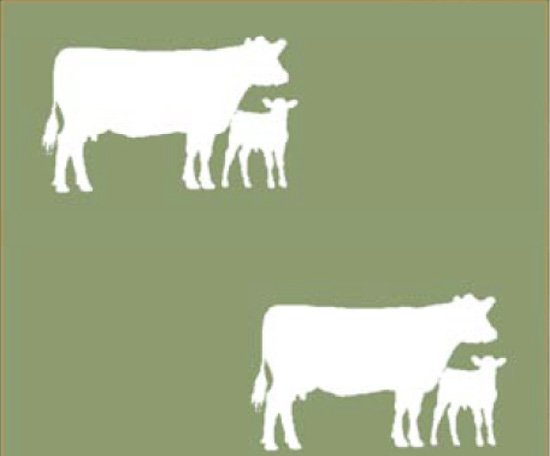
Areas can be fenced off from continuous stocking during periods of surplus forage growth to help keep the forage being grazed from becoming overmature. The stockpiled forage can then be either grazed at a later date or harvested for hay. Stockpiling forage (deferred grazing) is where forage is allowed to accumulate for grazing at a later period. Tall fescue and bermudagrass are two forages often considered for stockpiling.
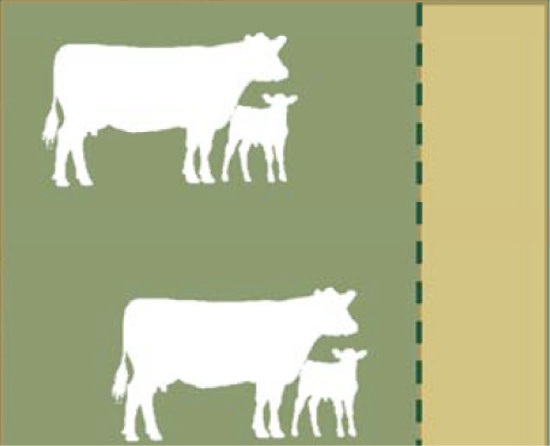
Rotational Stocking
An effective rotational or other intensively managed grazing system can be an affordable way to provide forage to grazing livestock and reduce herd nutrition costs year-round. Rotational stocking (rotational grazing) is a grazing method that uses recurring periods of grazing and rest among two or more paddocks in a grazing management unit through the period when grazing is allowed. With rotational stocking, grazing control and decision-making are switched from the animal to the manager. Having more control over grazing animals through rotational stocking allows the manager to better use forage supplies. A major benefit of rotational stocking is increased pasture carrying capacity when proper management is used. By moving cattle on a regular basis with rotational stocking, cattle become easier to handle. Managers observe cattle more often and can identify and address animal health or other problems more quickly.
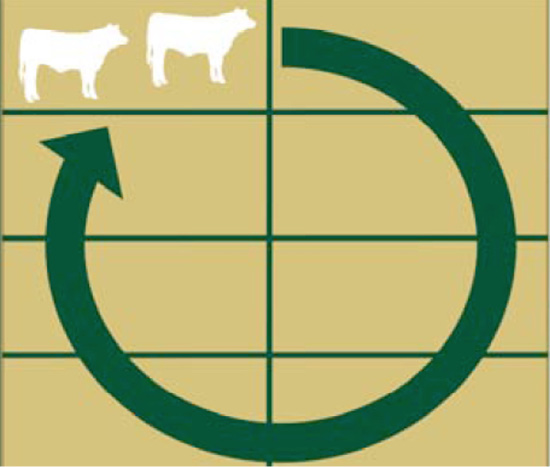
Pasture plants that are sensitive to close, continuous grazing are more persistent and productive in rotational stocking systems. Use of more forage species is improved with rotational stocking as weeds are eaten more than would otherwise occur. This reduces plant competition and favors pasture dominance by desirable forage species. Less forage is wasted by trampling with rotational stocking. Excess forage in ungrazed paddocks can be harvested for hay during periods of forage surplus growth.
Fencing paddocks separately based on forage species dominance and concentrating animals in smaller areas for shorter periods facilitates better pasture management and forage use. Better overall forage management often results with rotational stocking due to closer observation of both pastures and cattle. Manure and urine distribution is more uniform with rotational stocking. Environmental benefits of rotational stocking result from strategic fencing of cattle out of surface water sources and stream banks, protecting water quality and reducing erosion.
Rotational stocking is not without its challenges. Concerns with rotational stocking can include unproductive or low quality forage species, poor forage stands, low soil fertility, soil acidity, unsatisfactory layout, overstocking, extended rest periods, and cost.
Strip Grazing
Strip grazing involves confining animals to an area of land to be grazed in a relatively short period of time, where the paddock size is varied to allow access to a specific land area. With strip grazing, a temporary fence line is progressively moved across a pasture. In some instances, animals are allowed access to previously grazed strips along with ungrazed strips. In other cases, a back fence line is moved to keep cattle off of previously grazed strips.

Mob grazing is a variation of strip grazing where a large number of animals are grazed on a relatively small number of acres to rapidly remove forage from the paddock. Mob grazing is useful when forage growth needs to be removed prior to sodseeding another forage crop in the same paddock. Mob grazing is sometimes called flash grazing.
Creep Grazing
Creep grazing is a form of preweaning supplementation of nursing calves. It is the practice of allowing nursing calves to graze areas that their dams cannot access at the same time. This is accomplished through use of a creep gate that the calves can pass through freely but their dams cannot.
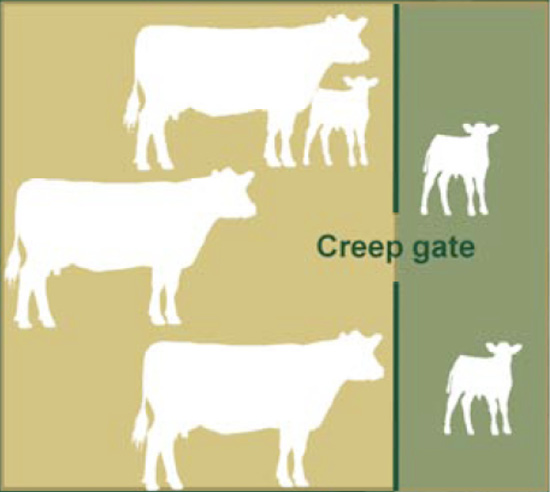
Forward creep grazing is a method of creep grazing in which dams and calves rotate through a series of paddocks with calves as first grazers and dams as last grazers. Calves, therefore, have more opportunity for selectivity than their dams. This is a specific form of forward grazing. Forward grazing (leader-follower, preference-follower, top and bottom grazer, first-last grazing) is a method of allowing two or more groups of animals, usually with different nutritional requirements, to graze sequentially on the same land area.
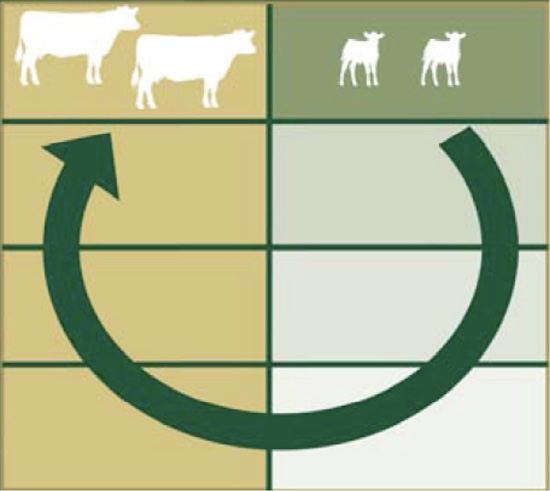
Limit Grazing
Limit grazing is where livestock are maintained on lower-quality pasture but allowed to access a higher quality pasture (typically winter annual grass pasture) for a few hours each day or every few days. Waste from trampling is reduced with this method. This method provides good nutrition at a relatively low cost because the area needed for high-quality pasture is relatively small. Cattle learn to move to and from paddocks with relative ease after a routine is established.
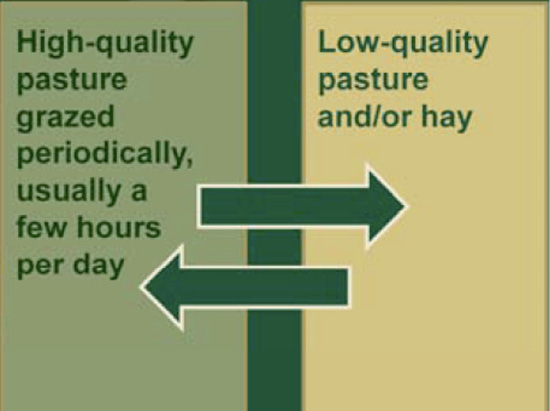
Grazing Management Formulas
Grazing formulas help in planning grazing management. To determine the number of paddocks needed, divide the number of paddock rest days by the number of grazing days and then add 1 to the result. For example, eight paddocks are needed for 4-day grazing periods with 28-day rest periods.
Number of paddocks (Days of rest / Days of grazing) + 1
Example: (28 days of rest / 4 days of grazing) + 1 = 8 paddocks
To compute the number of acres needed per paddock, multiply the following: average animal weight, dry matter consumed per animal as a percentage of body weight, number of animals, and days on the pasture. Then take the result and divide by the following: dry matter available in grazing area multiplied by the percent of dry matter used by grazing. For example, 40 600-pound steers consume 3 percent of their body weight in dry matter per day and will be on the pasture for 4 days. Pasture utilization is approximately 60 percent with 12 inches of forage growth and a thick stand (12 x 225 lb/inch). The number of acres needed per paddock in this scenario is 1.8 acres.
Number of acres needed per paddock =
(Average weight of animals grazing × Dry matter consumed, %BW × Number of animals × Days on pasture) / (Dry matter available in grazing area × Percent dry matter used by grazing)
Example: (600 × 0.03 × 40 × 4) / (12 × 225) = 1.8 acres
There are some things that must be considered when using this equation. In a given day, grazing cattle generally consume anywhere from 2 percent to more than 3 percent of their body weight in dry matter. Actual intake varies due to changes in the quality of pasture available and the class of animal that is grazing. For example, daily dry matter intake of a growing steer may be around 3 percent of body weight, whereas for a non-lactating beef cow it will be closer to 2 percent of body weight. Also, the dry matter available varies depending on the forage species, sward density, and growing conditions. A range to consider is between 150 and 300 pounds of dry matter in every usable inch of pasture growth. The percent of dry matter used varies with grazing method and duration. The typical range is usually within 40 to 70 percent. For example, higher stocking rates with shorter grazing durations lead to usage rates on the higher end of this scale.
Total acres required equals the number of paddocks times the number of acres required per paddock. Using the values from the previous examples (eight paddocks and 1.8 acres per paddock), the total acres required in this example is 14.4 acres.
Total acres required =
Number of paddocks × Area required for paddocks
Example: 8 paddocks × 1.8 acres / paddock = 14.4 total acres required
Stocking rate equals the number of animals grazing divided by the total number of acres grazed. Continuing the example above with 40 steers, the stocking rate is 2.8 steers per acre.
Number of animals to be grazed / Total area grazed = Stocking rate
Example: 40 steers / 14.4 acres = 2.8 steers per acre
Stocking density equals the number of animals grazed divided by the paddock size in acres. Continuing the same example, the stocking density is 22 steers per acre.
Number of animalsgrazing / Paddock size in acres= Stocking density
Example: 40 steers / 1.8 acre paddock = 22 steers per acre
Stocking Rate
“Mott’s curve” shows the relationship between animal output (per animal and per unit of land area) and pasture stocking rate (Figure 2). As forage production increases, stock numbers should increase to use the increased forage growth. At a low stocking rate, available forage and productivity per animal tend to be high, but output per acre is low. Stocking a pasture below the optimum rate for output per acre allows for selective grazing (selection of higher-quality forage) that improves animal productivity. Yet output per animal can be compromised at very low stocking rates (undergrazing situations) if forage growth becomes excessive and increasing forage maturity lowers forage quality to the point where selective grazing does not overcome quality declines. Animal dry matter intake and nutrient intake decline with the accumulation of stems and dead forage, lowering animal output.

As stocking rate increases, less forage is available per animal. Animals compete for forage and have less opportunity to select green, leafy forage, so animal performance falls. At the same time, animal output per acre initially increases with stocking rate due to increased forage use. As stocking rate continues to increase, animal gains continue to decline to the point that animal output per acre eventually peaks with animal additions to the pasture and then declines as the additional animals carried by the pasture does not compensate for the reduced rates of gain.
At very high stocking rates, plant leaf area is not sufficient for adequate photosynthesis, plants are defoliated below their growing points, and, in some cases, plants are weakened, and forage growth is depressed. In addition to lower forage production, closely grazed pastures may have more internal parasites. This overgrazing results in both low rates of animal weight gain and low gains per acre.
Paddock Layout
Paddock layout is critical when planning forage utilization programs. The number and size of paddocks needed depends upon the total acreage available, number of cattle to be grazed, intended stocking densities, number of paddock rest days desired between grazing rotations, and resources available to establish adequate fencing, water, and shade for each paddock.
The perimeter of each paddock needs to be fenced. The amount of fencing material needed depends on paddock shape. To fence 1 acre, 744 feet of fencing is needed for a circle. This is compared with 1,040 feet of fencing needed for a rectangle with a length 4 times its width. Paddock shapes in order from most efficient perimeter fencing requirements to least efficient are circle, square, rectangle with length two times width, equilateral triangle (sides of equal length), right triangle (two sides of equal length and a 90-degree angle in one corner), and rectangle with length four times width.
Livestock protection and confinement are not the only reasons to consider fencing. Fences can significantly increase livestock grazing efficiency. Proper fencing layout is a powerful management tool in efficient grazing systems.
The first step in planning livestock fencing is determining the purpose and goals of the fencing program. Fencing needs vary depending on the type of grazing management system and livestock species, class, and age. Determine the operation size, number of animals, type of forage system, and number of paddocks needed before investing in fencing materials and supplies. Many effective fencing options are available to livestock producers. Whether used as permanent or temporary confinements, fences should be carefully planned and constructed for efficient use, long life, and low maintenance.
In addition to keeping livestock out of the neighboring pastures and off of roadways, fencing is a key component of good grazing management. Fencing allows control over the movement of livestock and the productivity, quality, and use of forage crops. Low-cost, semi-permanent, and temporary electric fencing systems make controlling and efficiently using pasture resources easier than ever. Well-designed fencing, water, and shade systems can make a big difference in animal comfort and productivity as well as labor efficiency. These systems should be functional upon the arrival of livestock and must be monitored and maintained throughout the year. For detailed information on fencing, refer to Extension Publication 2538 Livestock Fencing Systems for Pasture Management.
Forage species, soil types, and drainage affect ideal size and placement of paddocks for grazing systems. The locations of water, feeding areas, and shade affect grazing distribution within paddocks. Cattle tend to congregate in these areas. Cattle should not have to travel long distances to access water or shade. Provide adequate quantities of shade and water sources capable of supplying adequate water to meet the needs of the cattle to be grazed.
Gate location affects how easily cattle move in and out of paddocks. Cattle move easiest along fence lines into corners. Gate placement in the middle of a fence makes cattle rotation more difficult. The inclusion of lane systems further eases cattle movement among paddocks. Natural boundaries such as tree lines may influence paddock layout. Paddocks should not be so far from cattle handling facilities that routine and emergency handling becomes difficult.
Livestock Grazing Behavior
Mature cattle can consume up to 20 percent of their weight in fresh forage each day. Cattle move slowly over pastures, taking approximately 30 to 60 bites per minute. They use their tongues to draw forage into their mouths and pull or tear it from the plants by holding it firmly between their lower incisor teeth and hard upper dental pad (gums). Cattle normally graze for 6 to 11 hours per day. Forage characteristics can affect grazing time. For example, grazing time and forage intake is reduced on toxic endophyte-infected tall fescue as compared with non-toxic tall fescues. Cattle usually have two major grazing bouts during a 24-hour period, just before dusk and just after dawn. Shorter grazing periods occur throughout the day and night. After a grazing bout, cattle rest (often lying down) and ruminate (chew their cud). During rumination, cattle regurgitate forage harvested during grazing. They then chew the bolus of regurgitated forage, mixing it with saliva. The forage is then swallowed again for further digestion in the rumen. Cattle typically ruminate for 5 to 9 hours daily.
When animals have access to a number of different pasture plant species or maturities, they show distinct preferences. Pastures must have sufficient leafy, green forage available to allow animals to quickly satisfy their appetites by selective grazing. Grazing animals find dead leaves less acceptable and often avoid them when other forage is available. When grazing animals are given access to fresh pasture, they consume the best-quality forage first. Continuous stocking allows animals to selectively graze unless the stocking rate is too high. Rotational stocking often reduces the opportunity for animals to select only the leafiest forage, resulting in decreased overall quality of forage consumed and sometimes lower animal gains, especially on low-quality forages.
Different grazing animal species have different forage preferences. Cattle generally prefer grasses over legumes. Cattle consume approximately 65 to 75 percent grasses, 20 to 30 percent broadleaf weeds and legumes, and 5 to 10 percent browse (shrubs or trees). Deer typically prefer legumes to grasses. White-tailed deer consume approximately 10 to 30 percent grasses, 30 to 50 percent broadleaf weeds and legumes, and 30 to 50 percent browse. Horses are more selective than cattle, tend to spot graze, and bite off forage very closely. Horses consume approximately 70 to 80 percent grasses, 15 to 25 percent broadleaf weeds and legumes, and 0 to 5 percent browse.
Goats select higher-quality leafy forage than cattle during grazing. They consume the more nutritious parts of coarse weeds, brush, grasses, and legumes. Goats consume a wider range of plants than cattle and tolerate bitter tastes, including plants containing large amounts of tannins. The biting action and small mouths of sheep and goats allow more selective and closer grazing than the tearing action of cattle. Goats consume approximately 20 to 30 percent grasses, 10 to 30 percent broadleaf weeds and legumes, and 40 to 60 percent browse. Sheep consume approximately 45 to 55 percent grasses, 30 to 40 percent broadleaf weeds and legumes, and 10 to 20 percent browse.
Forage availability is the most important factor affecting forage intake on pasture. Intake is restricted when insufficient forage is available, such as during a drought. On good quality pasture, intake is adequate when available forage is 1,000 to 1,500 pounds per acre dry forage. A range of 150 to 300 pounds of dry matter for each inch of usable pasture growth is common, but considerable variation will occur based on forage species, growing conditions, and density. Cattle harvest forages with their tongues, so very short forage height can limit bite size. With low levels of available forage, the amount that can be collected with each bite is small, and the animal will have to walk further to take more bites, allowing less time for chewing and ruminating.
The proportion of leaf to stem can greatly affect the bite size as the animal seeks out leaves. Higher proportions of stems effectively reduce bite size even though total forage available is adequate. When stocking rate is high, cattle on rotationally stocked pastures may be forced to eat more stem or low-quality forage, which can reduce intake. This is in contrast to a continuously grazed pasture where they usually have a greater opportunity for selectivity unless the pasture is overstocked and has low forage availability. Warm-season perennial grasses (bermudagrass, bahiagrass, dallisgrass) with a higher proportion of stem may require the animal to harvest more but smaller bites to obtain the desired forage. Cattle eat little dead material if green leaf is available. Thus, bite size may be restricted as the grazing animal seeks out green leaves. Increased grazing time is often not enough to compensate for the effects of reduced bite size on forage intake when cattle are grazing short pasture.
Several methods are available to determine the amount of available forage. Clipping and weighing the forage in a given area is the most accurate method but requires drying and weighing clipped forage. This method is time consuming. A falling plate meter measures the height of forage while it is depressed under a weighted plate. It takes density into account and is therefore more accurate than measuring the height. The rising plate meter is a similar tool for evaluating forage availability. Measuring the height of existing forage using calibrated rulers (“grazing sticks”) is usually an easy method but is less reliable because it does not take stand density into account. For detailed instructions on assessing available forage, refer to Extension Publication 2458 Assessing Needs and Feed Sources: How Much Forage Do I Have?
Effects of Grazing Animals on Pastures
Grazing animals affect pasture productivity and forage species populations via defoliation, treading, and excretion. Defoliation is the harvest of plant shoots or leaves by the grazing animal. It has the largest influence on a pasture of the three factors listed here. Cattle graze by wrapping their tongues around and then pulling plants to consume forages. Defoliation effects on pastures depend on forage species present, extent of selective grazing of different plant species, defoliation frequency, extent of defoliation, stage of plant development, and environmental conditions at time of defoliation.
Reduced leaf area from grazing affects plant food production and storage, shoot development, leaf and root growth, light intensity in the lower portion of the forage canopy, soil temperature, and soil moisture. Overgrazing results in weak plants, reduced root systems, lower forage yield, greater soil erosion and water runoff, thinned forage stands, and more weeds. Undergrazing wastes forage and reduces overall forage nutritive quality. Overgrazing and undergrazing each favor some forage and weed species over others.
Trampling of pastures by livestock hooves damages plants, compacts soil, and reduces water infiltration on clay soils. Treading damage is most severe during extremely wet periods, on clay soils, on recently tilled soils, and with short forage.
Cattle normally urinate 6 to 11 times daily and defecate 10 to 18 times daily. This excretion concentrates nutrients on only about 20 percent of the pasture. Nutrients are further concentrated in areas where cattle congregate such as under shade and in water and feeding areas. Specifically, nitrogen is concentrated in urine spots and phosphorus is concentrated in manure patches. Cattle tend to graze around these excretion sites, reducing the amount of grazeable forage in a pasture.
Conclusion
Management of both forage and grazing animals is the key to successful grazing operations. A good goal is to develop a grazing system that uses properly managed and well-adapted forages while at the same time meeting the nutrient requirements of the animals. Various grazing management tools are available to better equip cattle producers to more effectively use forage resources and rely less on supplemental feeds.
Grazing systems are management tools designed to enhance and stabilize livestock production over time. They are designed to balance the conflicting relationships between energy capture, harvest, utilization, and conversion efficiencies of the available forage. The level of beef cattle production on a given site varies due to both plant and animal factors. Determining the optimum number of animals that can be placed in a specific area over a period of time is essential for the success of any grazing management strategy. This affects both animal performance and production per acre.
Design grazing management systems to efficiently improve forage utilization and energy conversion (quality) of the forage produced or consumed. Properly manage grazing pressure and intensity to achieve this. Recognize patterns in cattle grazing behavior that can help to tailor forage systems to better meet their needs.
Every beef cattle operation is different (cattle class, forage adaptability, soil types, water availability, rainfall patterns, etc.). There is not one universally superior grazing system for all operations. Therefore, understanding grazing management concepts and the pros and cons of different systems can help in choosing appropriate grazing management strategies for the specific beef cattle operation. For more information on beef cattle grazing management or related topics, contact your local MSU Extension office.
References
Ball, D. M., C. S. Hoveland & G. D. Lacefield. 2007. Southern Forages. 4th ed. International Plant Nutrition Institute. Norcross, GA.
Mott, G.O. 1973. Evaluating forage production. In ME Heath, DS Metcalfe, and RF Barnes (eds.), Forages: The Science of Grassland Agriculture. 3rd ed., 126–135. Ames: Iowa State University.
Petersen, R. G., H. L. Lucas & G. O. Mott. 1965. Relationship between rate of stocking and per animal and per acre performance on pasture. Agron. J., 57: 27–30.
USDA. Economic Research Service. 2010. Commodity Costs and Returns.
The information given here is for educational purposes only. References to commercial products, trade names, or suppliers are made with the understanding that no endorsement is implied and that no discrimination against other products or suppliers is intended.
Publication 2629 (POD-10-21)
Reviewed by Brandi Karisch, PhD, Associate Extension/Research Professor, Animal and Dairy Sciences; written by Jane A. Parish, PhD, Professor and Head, North Mississippi Research and Extension Center; J. Daniel Rivera, PhD, former Associate Research/Extension Professor, South Mississippi Branch Experiment Station; Holly T. Boland, former Assistant Research/Extension Professor, Prairie Research Unit; and Rocky Lemus, PhD, Extension/Research Professor, Plant and Soil Sciences.
The Mississippi State University Extension Service is working to ensure all web content is accessible to all users. If you need assistance accessing any of our content, please email the webteam or call 662-325-2262.




